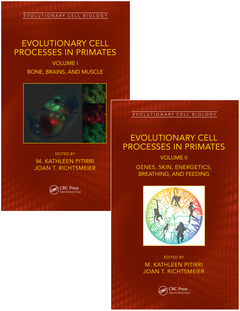Description
Evolutionary Cell Processes in Primates
Two Volume Set
Evolutionary Cell Biology Series
Coordinators: Pitirri M. Kathleen, Richtsmeier Joan T.
Language: English
Subjects for Evolutionary Cell Processes in Primates:
· 15.6x23.4 cm · Hardback
Description
/li>Contents
/li>Biography
/li>
These two volumes demonstrate the role of cellular mechanisms in the production of the many specialized traits defining primates. By exploring gene activity transforming into evolutionary change through the work of cellular mechanisms, the goal is to encourage others to adopt evolutionary cell biology as an approach to the genotype-phenotype map of the diversification of primates, human variation, and human evolution. Contributors highlight how genetic analysis, visualization of cells and tissues, and merging Evo-Devo with evolutionary cell biology combine to answer questions central to understanding the human and primate evolution.
Key Features
- Explores the developmental basis of characteristics that define the primate lineage
- Documents cellular mechanisms associated with everything from skin and eneregetics to the brain and communication.
- Chapters by a team of leading international researchers
M. Kathleen Pitirri, PhD is a Postdoctoral Scholar in the Department of Anthropology at Pennsylvania State University. She received her PhD from the University of Toronto in 2019 where she studied primate evolution, focusing specifically on the taxonomic, ontogenetic, and functional basis of mandibular shape variation in living and fossil primates. During her PhD research, Dr. Pitirri developed a novel methodology for studying shape variation of mandibular fragments that are part of the primate fossil record. She found a strong relationship between the shape of the mandibular corpus and molar crypt formation in great apes, suggesting that mandibular shape is linked to an extended period of development in great apes, representing an important evolutionary shift in primates. Upon joining the Richtsmeier Lab, Dr. Pitirri began using mouse models to study the cellular mechanisms involved in transferring information from the genotype to the phenotype. The changes observed in mouse models can be used to interpret the cellular basis for changes observed in skull shape in primates because mechanisms that build the craniofacial skeleton during development also drive variation in disease and evolution. Dr. Pitirri is particularly interested in the evolutionary consequences of change in developmental processes driving the patterning of cellular activities involved in embryogenesis of skull bones, the role of the chondrocranium in skull development, and the genetic pathways regulating the relationship between tooth and bone formation during embryonic development.
Joan Richtsmeier is Distinguished Professor of Anthropology at the Pennsylvania State University. She received her PhD from Northwestern University in 1985 and joined the faculty of the Department of Cell Biology and Anatomy, Johns Hopkins University School of Medicine in 1986. There, she focused on establishing new quantitative methods for studying change in biological shape through time, espe




